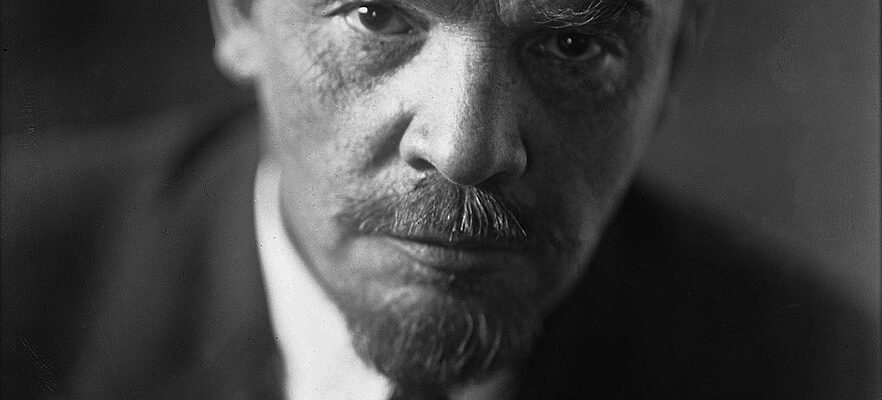Biography of Vladimir Lenin
Vladimir Ilyich Ulyanov was born on April 22, 1870 in Streletskaya Ulitsa, Simbirsk, now Ulyanovsk, Russia to Ilya Nikolayevich Ulyanov and Maria Alexandrovna Blank. Lenin was a very smart child, graduating top of his class before attending Kazan University. He lost both his father and his older brother, Alexander, at a young age. Ilya died of a brain hemorrhage in 1886 and Alexander was executed later the same year for conspiracy to assassinate Tsar Alexander III.
Lenin was arrested and then expelled from Kazan University for leading a demonstration against government restrictions that banned student societies. The Ministry of Internal Affairs exiled him to his family’s estate in Kokushkino. There he would first be introduced to revolutionary ideas. Lenin’s mother was able to convince the Ministry of Internal Affairs to let him return to Kazan (but not for school). There he was introduced to the works of Karl Marx.
Lenin would move to St. Petersburg in 1893. There, he would meet his future wife Nadezhda “Nadya” Krupskaya. He would also get exiled for a second time in 1897. He was sentenced to 3 years in Siberia. Nadya would be exiled to Siberia in 1898 and they would marry a few months later. After Lenin’s second exile in 1900, he would move to Munich where he established his newspaper, Iskra (translation: Spark). With the newspaper, he first adopted the pseudonym Lenin. In 1902, he moved to London where he met fellow Marxist and future revolutionary, Leon Trotsky.
Lenin would return to St. Petersburg after the Revolution of 1905, believing it safe for him to return following Tsar Nicholas II’s liberal reforms. He would meet Stalin wile back in Russia. He would only stay for two years before he was forced out in fear of being arrested by the Tsar’s attempt at getting rid of opposition. Lenin and his wife would move throughout Europe before finally settling in Bern, Switzerland.
In 1917, with Russia struggling in World War I, the February Revolution succeeded to force Tsar Nicholas II to abdicated. Lenin believed that this was the perfect time to return to Russia. However, Russia continued to fight in the war so there was no way for him to travel. He was able to make a deal with Germany that if they got him back to Russia, he would take control and make Russia exit the war. So with the help of the German government, Lenin traveled back to Russia.
It would take Lenin until October to take control of Russia. Interestingly enough though, he was not in St. Petersburg for most of the Revolutionary period. He was hiding in Helsinki, Finland because the provisional government were trying to arrest him. He arrived in St. Petersburg at the start of October and would lead a relatively bloodless coup that would end in victory for the Bolsheviks.
Lenin was voted to lead this new government. Lenin would sit as chairman of this new government until his death in 1924. Lenin’s time in charge was filled with conflict and oppression. His armies were fighting someone throughout most of his reign. At first, it was the Germans and Austro-Hungarians. After being beaten by the Central Powers, the nation was in ruin and Russia would enter a civil war. Lenin would slowly beat his opposition, but by the civil war ended in 1923, Lenin was slowly dying.
On January 21, 1924, Lenin fell into a coma and died later that day in his Gorki Mansion. On January 27, his body was transported to Moscow, the new capital of Russia, where it was place in a mausoleum. As of May 2021, his body still remains in a transparent casket inside the mausoleum.
Lenin’s Testament
In March of 1923, Lenin had his third stroke1Dmitri Volkogonov, Lenin: Life and Legacy, trans. Harold Shukman (London:HarperCollins, 1994), 425.. He was forced to spend more and more time away from the government in his Gorki Mansion. Determined to shape the Soviet Union towards a better future, he decided to write a letter to his comrades in the government. Over a span of 13 days – December 23, 1922 to January 4, 1923 – Lenin would write his three part letter. In the first part of the letter, Lenin proposed changes to the government’s structure and personnel. He wanted reforms in the Central Committee for fear that it “would be in great danger if the course of events were not quite favourable for us2Vladimir Lenin, “Vladimir Lenin to the Congress of the Soviet Union”, Letter, Moscow: Kommunist, December 22, 1922 to January 4, 1923, Vol. 36. 593-611, From Lenin Internet Archives, Lenin Collected Works, https://www.marxists.org/archive/lenin/works/1922/dec/testamnt/congress.htm..” In the second part, Lenin purposed that the State Planning Commission be given more legislative power. He believed that, for certain situations, the State Planning Commission had more expertise and knowledge than the Central Committee. In the third and final part of the letter, Lenin questions the role of nationalism. He wanted his successors to rid the Union of nationality to create a more unified Soviet state.
Contents of the Letter
Stalin is too rude and this defect, although quite tolerable in our midst and in dealing among us Communists, becomes intolerable in a Secretary-General. That is why I suggest that the comrades think about a way of removing Stalin from that post and appointing another man in his stead who in all other respects differs from Comrade Stalin in having only one advantage, namely, that of being more tolerant, more loyal, more polite and more considerate to the comrades, less capricious, etc.
Vladimir Lenin (1923)
Events following Vladimir Lenin’s Death
By the time of Vladimir Lenin’s death, Joseph Stalin had already consolidated power in the Central Committee. As described in Leon Trotsky’s “On the Suppressed Testament of Lenin,” Stalin suppressed the letter from both the public and congress. The letters would not be released until 1953 by Nikita Khrushchev’s Soviet government.
Significance and Impact on the 20s
Lenin’s Testament has huge significance, but little impact on the 1920s. Because Stalin suppressed the letter, Lenin was not able to hurt him postmortem. Even if he did not suppress it, Stalin probably had too much power for it to actually do anything. Any protests caused from the letter would have been violently suppressed.
However, this letter shows that Stalin was not supposed to be Lenin’s successor. Based on the letter, Lenin could have potentially chosen Trotsky to lead the nation. Trotsky was a strong leader who organized the events leading to the October Revolution and he controlled the army during the civil war. Another possibility would be one of the younger communists like Nikolai Bukharin or Georgy Pyatakov. Bukharin in particular was very popular among the communists and according to Lenin, “a most valuable and major theorist3Vladimir Lenin, “Vladimir Lenin to the Congress of the Soviet Union”, Letter, Moscow: Kommunist, December 22, 1922 to January 4, 1923, Vol. 36. 593-611, From Lenin Internet Archives, Lenin Collected Works, https://www.marxists.org/archive/lenin/works/1922/dec/testamnt/congress.htm..”
Citations
Bibliography
Fischer, Louis. The Life of Lenin. London: Weidenfeld and Nicolson, 1964.
Lenin, Vladimir. “Vladimir Lenin to the Congress of the Soviet Union”. Letter. Moscow: Kommunist, December 22, 1922 to January 4, 1923. Vol. 36. 593-611. From Lenin Internet Archives. Lenin Collected Works. https://www.marxists.org/archive/lenin/works/1922/dec/testamnt/congress.htm.
Sebestyen, Victor. Lenin the Dictator: An Intimate Portrait. London: Weidenfeld & Nicolson, 2017.
Trotsky, Leon. “On the Suppressed Testament of Lenin”. The New York Times, October 18, 1926. From Lenin Internet Archives. Trotsky Collected Works. https://www.marxists.org/archive/trotsky/1932/12/lenin.htm.
Volkogonov, Dmitri. Lenin: Life and Legacy. Translated by Shukman, Harold. London: HarperCollins, 1994.

Michael Kilduff is a history major at Ramapo College of New Jersey. He is looking to become a high school history teacher after going to graduate school for history education.

